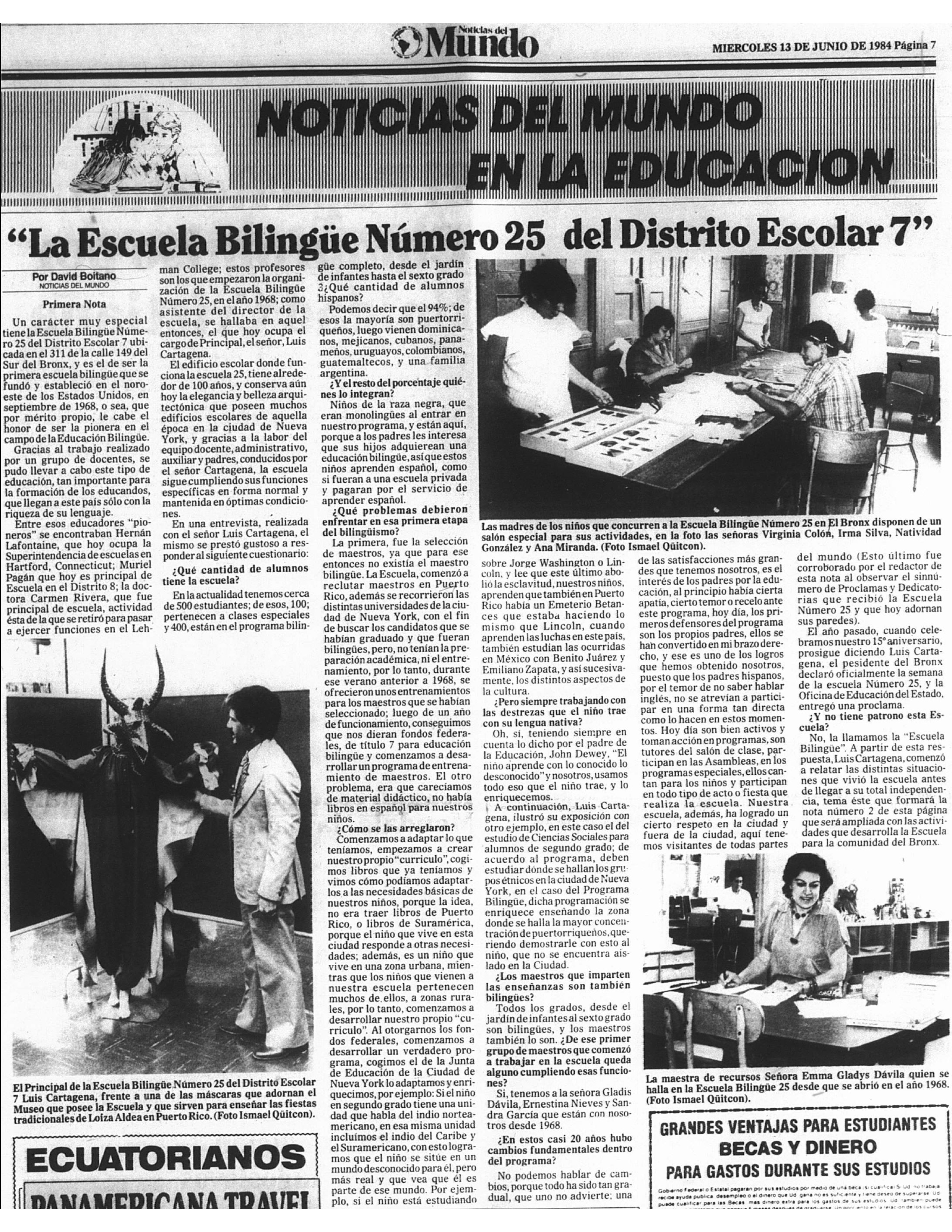La Escuela Bilingüe Número 25 del Distrito Escolar 7

Date: Jun 13, 1984
Caption: Spanish-language newspaper Noticias del Mundo discussed a new Spanish-English bilingual school in the Bronx and interviewed its principal, Luis Cartagena.

Please note: This is work in progress. Please keep that in mind as you read. We are sharing this work in progress because these materials are relevant to discussions of school governance underway right now in New York. Please share your feedback at [email protected] and check back for updated versions soon.
Many Puerto Rican families migrating to New York from the island in the 1950s and 1960s settled in the South Bronx, where their children enrolled in school. Coming from homes where Spanish had been the primary language, coming often from rural settings to a big city, and coming to a new climate and cultural environment all created challenges for Puerto Rican migrant students.
How did New York City’s schools respond? Too many schools thought of students’ native Spanish language as a deficit rather than as an asset. But small groups of educators and parents in neighborhoods with large Puerto Rican populations created ways to help students learn English and adjust to their new home while maintaining their Spanish language and celebrating their home culture.
One of the first of these new Spanish-English bilingual schools in the US opened in the South Bronx during the decentralization period. Community School District 7 supported the creation of the new school. Evelina López Antonetty and the organization she founded, United Bronx Parents, also supported the effort. Community School District 4 in East Harlem, where many Puerto Ricans lived, also developed bilingual education programs.1
A small Spanish language newspaper, Noticias del Mundo, published this article about the school. Historian Laura J. Kaplan located this article in her research on bilingual education at P.S. 25.2
-
Heather Lewis, New York City Public Schools from Brownsville to Bloomberg (New York: Teachers College Press, 2011). ↩︎
-
Laura J. Kaplan, P.S. 25, South Bronx: Bilingual Education and Community Control (Ph.D. diss., CUNY Graduate Center, 2018), and available online at https://academicworks.cuny.edu/gc_etds/2957. ↩︎
Categories: K-12 organizing, Bronx, teacher activism
Tags: bilingual education, Spanish language, immigrants and migrants, curriculum, joy, women's activism, newspapers and the media, Latinx people, Black people, the arts
This item is part of "Decentralization: Community School Districts For Some" in "Who Governs Schools?"
Item Details
Date: Jun 13, 1984
Creator: David Boitano
Source: Noticias del Mundo
Copyright: Under copyright
How to cite: “La Escuela Bilingüe Número 25 del Distrito Escolar 7," David Boitano, in New York City Civil Rights History Project, Accessed: [Month Day, Year], https://nyccivilrightshistory.org/gallery/la-escuela-bilingue.
Questions to Consider
- Do you think P.S. 25 met its goal of celebrating the Spanish language and Latinx cultures? What evidence can you find in the article?
- Parents at the school are mentioned in both the text and the article. How does this article’s discussion of parents compare to the approach to parents taken in A Day’s Work in a New York Public School?
- The education provided at P.S. 25 appears to be an early example of what educators today call “culturally sustaining pedagogy,” or teaching that respects and builds on the cultures that children bring with them to school. Has your school been culturally sustaining for you? What suggestions do you have to make it more so?
References
How to Print this Page
- Press Ctrl + P or Cmd + P to open the print dialogue window.
- Under settings, choose "display headers and footers" if you want to print page numbers and the web address.
- Embedded PDF files will not print as part of the page. For best printing results, download the PDF and print from Adobe Reader or Preview.
